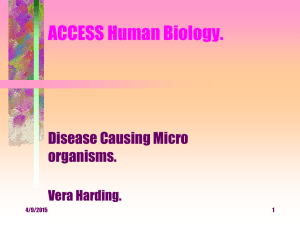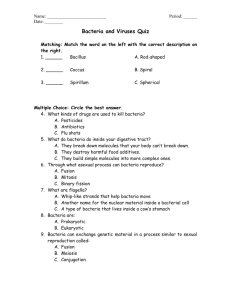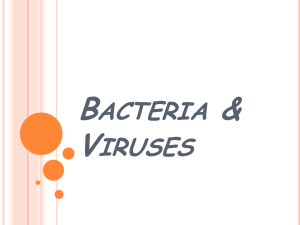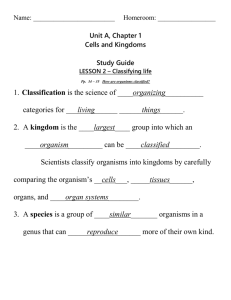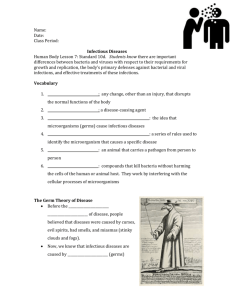8.L.1- Microbes and Disease - NHCS
advertisement
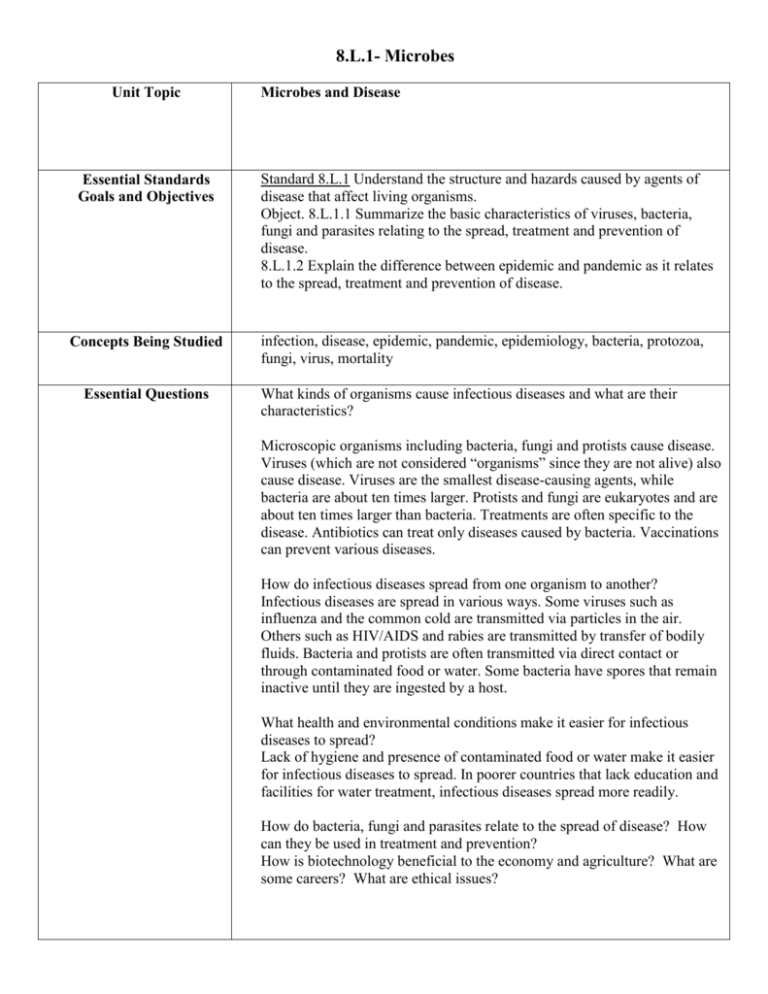
8.L.1- Microbes Unit Topic Essential Standards Goals and Objectives Concepts Being Studied Essential Questions Microbes and Disease Standard 8.L.1 Understand the structure and hazards caused by agents of disease that affect living organisms. Object. 8.L.1.1 Summarize the basic characteristics of viruses, bacteria, fungi and parasites relating to the spread, treatment and prevention of disease. 8.L.1.2 Explain the difference between epidemic and pandemic as it relates to the spread, treatment and prevention of disease. infection, disease, epidemic, pandemic, epidemiology, bacteria, protozoa, fungi, virus, mortality What kinds of organisms cause infectious diseases and what are their characteristics? Microscopic organisms including bacteria, fungi and protists cause disease. Viruses (which are not considered “organisms” since they are not alive) also cause disease. Viruses are the smallest disease-causing agents, while bacteria are about ten times larger. Protists and fungi are eukaryotes and are about ten times larger than bacteria. Treatments are often specific to the disease. Antibiotics can treat only diseases caused by bacteria. Vaccinations can prevent various diseases. How do infectious diseases spread from one organism to another? Infectious diseases are spread in various ways. Some viruses such as influenza and the common cold are transmitted via particles in the air. Others such as HIV/AIDS and rabies are transmitted by transfer of bodily fluids. Bacteria and protists are often transmitted via direct contact or through contaminated food or water. Some bacteria have spores that remain inactive until they are ingested by a host. What health and environmental conditions make it easier for infectious diseases to spread? Lack of hygiene and presence of contaminated food or water make it easier for infectious diseases to spread. In poorer countries that lack education and facilities for water treatment, infectious diseases spread more readily. How do bacteria, fungi and parasites relate to the spread of disease? How can they be used in treatment and prevention? How is biotechnology beneficial to the economy and agriculture? What are some careers? What are ethical issues? Essential Information 8.L.1.1 Microbiology as a basic science explores microscopic organisms including viruses, bacteria, protozoa, parasites, and some fungi and algae. These organisms lack tissue differentiation, are unicellular, and exhibit diversity of form and size. Viruses, bacteria, fungi and parasites may infect the human body and interfere with normal body functions. A person can catch a cold many times because there are many varieties of cold viruses that cause similar symptoms. Viruses are not considered to be alive but they affect living things. Viruses need a host cell. AIDS, influenza, the common cold, polio, chicken pox, small pox, yellow fever, viral meningitis, West Nile and Ebola are caused by viruses. Rabies, Lyme Disease, bacterial meningitis, and Leprosy are caused by bacteria. Bacteria are very small organisms, usually consisting of one cell, that lack chlorophyll. Except for viruses, they are the smallest living things on Earth. Bacteria are found everywhere, in the air, soil, water, and inside of your body and on your skin. They tend to multiply very rapidly under favorable conditions, forming colonies of millions or even billions of organisms within a space as small as a drop of water. Bacteria are generally classified into three groups based on their shape: spherical, rodlike, spiral or corkscrew. We have antibiotics to help with bacterial infections and vaccines to help with taking care of viruses that cause infections. 8.L.1.2 Vectors are mechanisms (other than a person) that spread disease without getting sick itself. Rats, ticks, mosquitoes, and soil are examples of vectors. An infectious disease is one that can be passed from one generation to another. Scientists study microbial pathogens (disease causing agents), to find methods for prevention and treatment of disease. Improvements in public health depend upon state-of-the-art biomedical research to explain how microbes cause infectious diseases in both plants and animals. To analyze data, scientists use various techniques and strategies including computer modeling, cell culture, animal models, and clinical trials in humans. Safe handling and hygiene as well as various antimicrobial chemicals can be used to reduce the risk of and the treatment of these infections. Industrial microbiology involves quality control in preventing growth and contamination of products leading to food spoilage, and the production of pharmaceuticals. The health of humans and earth depends on microbes. An epidemic is an outbreak of a disease that affects a disproportionately large number of individuals within a population, community or region at the same time (example-typhoid). Pandemic is an epidemic of an infectious disease that is spreading through human populations across a large region, continent or even worldwide (examples smallpox, tuberculosis, flu of 2009). Essay Questions See Brief constructed response in tech book Project Ideas Microbe Wanted Posters Labeled Model of Virus or Bacterial cells Disease Brochures Disease Prezi Projects (pair or individual) Technology Labs, Experiments, Activities, etc. Resources PowerPoint’s on Black Plague, Biotechnology & power point on viruses, parasites, fungi, and bacteria. Videos from Discovery Education through Discovery Streaming Brain pop video and quizzes Science Techbook on discovery ed Simulation of the spreading of Disease using bromothymol blue The spread of microbes simulation using cards “The Sneeze” video/activity Microscopes with slides of microorganisms Microbes and size using chalk outside View finders with slides Hands on-Germs they are everywhere activity-techbook Look at yogurt under compound microscope- high power. Bacteria are small but you can see them moving around. Cells alive websitecomparison of size of viruses, bacteria, pollen, red blood cell. also has picturess of bacteria growth and other images Holt Science and Technology- Science book Ch. 20&21 Science Techbook on discovery education Websites YouTube Brain Pop Discovery Kids “microbe” magazines Microbiology Prezi : http://prezi.com/n9qd6bhtiq2p/microbiology/ http://microbezoo.commtechlab.msu.edu/zoo/index.html http://www.pbs.org/wgbh/nova/typhoid/dete-flash.html Assessment Infectious Disease Assessment- techbook Unit test Projects/rubrics Quizzes Exit slips Classwork Labs



